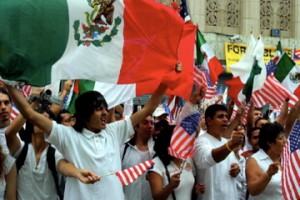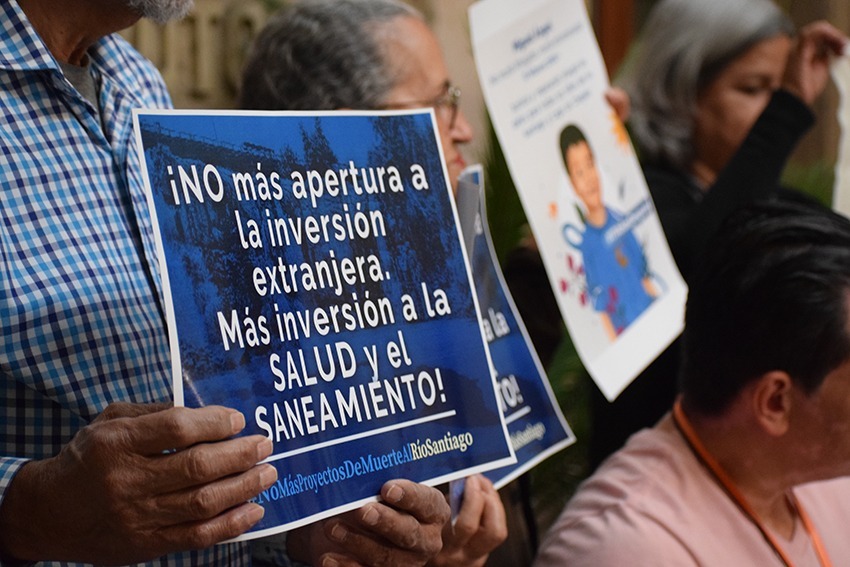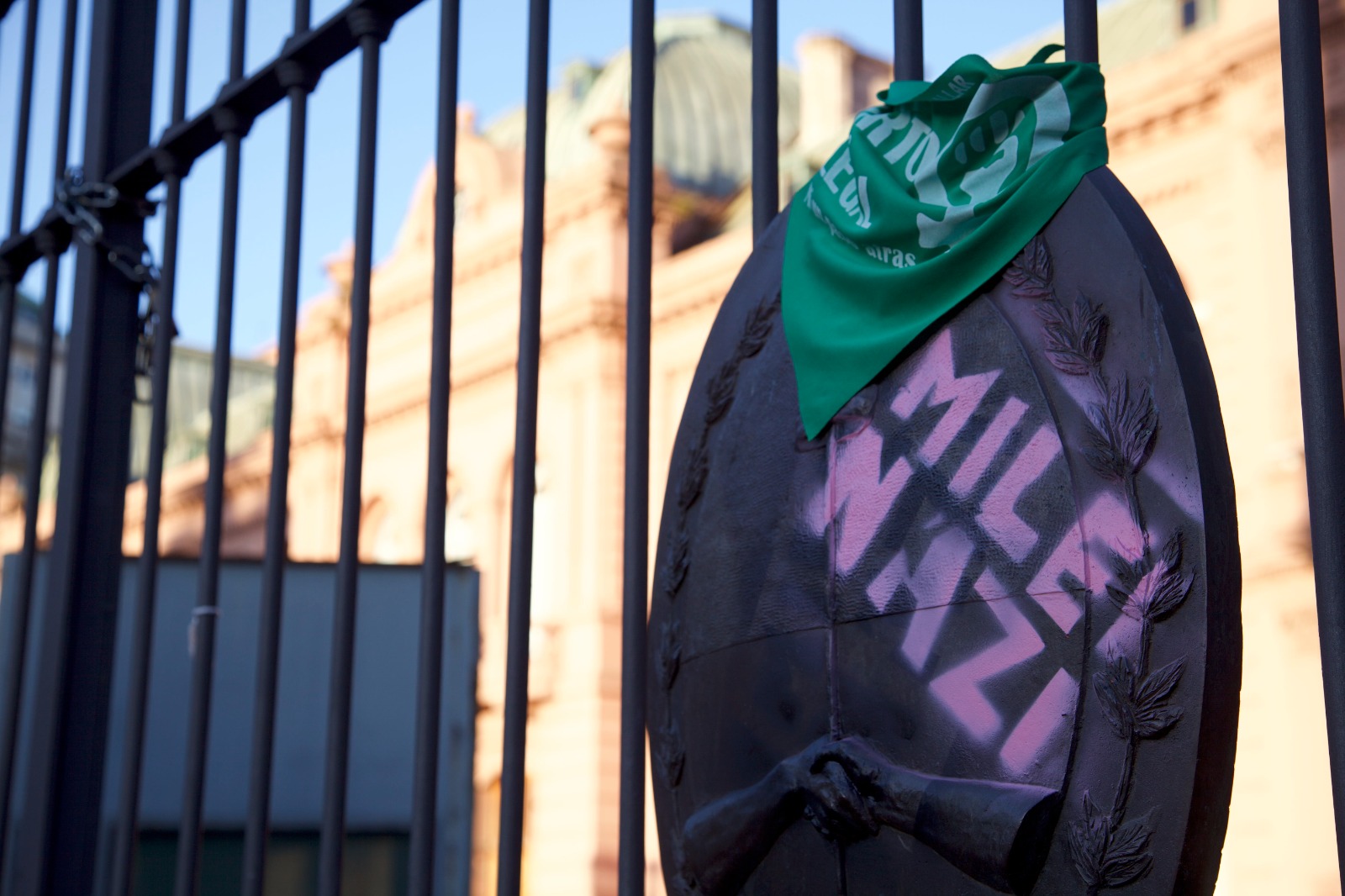 Editor’s Note: This is the first installment of a series on border solidarity by journalist and immigration activist David Bacon. This article and subsequent installments were originally published in the Institute for Transnational Social Change’s report Building a Culture of Cross-Border Solidarity. To download a PDF of the entire report, click here.
Editor’s Note: This is the first installment of a series on border solidarity by journalist and immigration activist David Bacon. This article and subsequent installments were originally published in the Institute for Transnational Social Change’s report Building a Culture of Cross-Border Solidarity. To download a PDF of the entire report, click here.
Introduction
In the period since the North American Free Trade Agreement has come into effect, the economies of the United States and Mexico have become more integrated than ever. Through Plan Merida and partnerships on security, the military and the drug war, the political and economic policies pursued by the U.S. and Mexican governments are more coordinated than they’ve ever been.
Working people on both sides of the border are not only affected by this integration. Workers and their unions in many ways are its object. These policies seek to maximize profits and push wages and benefits to the bottom, manage the flow of people displaced as a result, roll back rights and social benefits achieved over decades, and weaken working class movements in both countries.
All this makes cooperation and solidarity across the U.S./Mexico border more important than ever. After a quarter century in which the development of solidarity relationships was interrupted during the cold war, unions and workers are once again searching out their counterparts and finding effective and appropriate ways to support each other.
This paper is not a survey of all the efforts that have taken place, especially since the NAFTA debate restarted the solidarity process in the early 1990s. Instead, it seeks to set out some questions, and invite responses and contributions from people involved in this cross border movement. Among these questions are the following:
What is the history of cross-border solidarity? How can we discard the blinders forged by the cold war, and expand our vision of what is possible?
How is the political context changing on both sides of the border? Why is solidarity a necessary response to political and economic challenges?
One of our biggest advantages is the movement of people from Mexico to the U.S. and back. What part do migrants and the struggle for their rights play in solidarity between workers of both countries?
How can we develop new ways of reaching across the border?
The Hidden History of Mexico/U.S. Labor Solidarity
The working class movements of the U.S. and Mexico both began in the decades after the seizure of Mexican territory in the War of 1848, its incorporation into the territory of the U.S., and the unequal relationship cemented by the Treaty of Guadalupe Hidalgo.
After the turn of the century, cross-border solidarity became an important political movement, as Mexicans began migrating to the U.S. as railroad workers, miners and farm laborers. The Flores Magon brothers, on the run from the regime of Porfirio Diaz, began organizing what became the uprising in Cananea and the Liberal Party in the communities of railroad workers in Los Angeles, St. Louis and elsewhere north of the border.
The two were active participants in the radical socialist and anarchist movements of the day, and were associated with the Industrial Workers of the World. After the Cananea rising, J. Edgar Hoover pursued them in his first campaign of organized anti-labor and anti-left repression. The brothers were caught, tried and sent to Leavenworth Federal Prison, where Ricardo died.
Today in Salina Cruz, Oaxaca, on the wall of the longshore union hall, hangs a banner dated 1906, declaring the union part of the Casa Obrera Mundial. The Casa Obrera Mundial was a Mexican group associated with the Industrial Workers of the World (IWW), and the banner testifies to the links that existed between workers of the two countries at that time, and their internationalist outlook. Later, members of the IWW fought in the Mexican Revolution itself.
The roots of the cross-border solidarity movement are very deep, going back more than a century. They are part of the labor culture of workers and unions, and have been almost since the beginning of our two labor movements.
During the 1930s, strong cross border relationships developed between workers on both sides. In Mexico and the U.S., their challenge was the same – to organize the vast bulk of workers in the largest enterprises, especially the basic industries.
Through the presidency of Lazaro Cardenas, Mexican labor had a government that depended on a strong, albeit politically controlled, union movement. Communists and socialists organized the Confederation of Mexican Workers (CTM), and began supporting the beginnings of labor movements in other countries through the Confederation of Workers of Latin America (CTAL), headed by Vicente Lombardo Toledano.
In the U.S., the New Deal was a product of the upsurge in labor organizing led by the left, and in turn it also created a favorable environment in which many industrial workers were able to organize.
From that period to the present, the relationships between workers in the U.S. and Mexico grew closer when the left was strong, both in terms of organized political parties, but also as a set of ideas that were supported by large numbers of workers. From the beginning, the strongest relationships have existed between industrial workers – miners, railroad workers, factory workers, farm workers, longshore workers and others.
During the period of the labor upsurge of the 1930s and 40s, most solidarity activity was organized by Mexican unions in support of workers in the U.S. In part, this was due to a point of view among those unions that saw Mexicans and Mexican-Americans, especially along the border, as part of their own constituency. They sought to protect and defend the interests of people they viewed as their own paisanos.
In 1937 5000 workers marched to the bridge in Laredo during an onion strike in the Rio Grande Valley. The major working class organizations of the border states were present – the Congreso de Trabajo, the railroad union and the Mexican Communist Party. Vicente Lombardo Toledano came from Mexico City to speak.
Together with grassroots unions organized by left-wing workers on the U.S. side, the groups cooperated in setting up the Asociacion de Jornaleros (the Agricultural Workers Union) in Laredo, Texas. In the following years, Mexican unions increased their organizing activity in Texas. The CTM held Conventions of Mexican Workers in Dallas in 1938, in San Antonio in 1940, and in Austin in 1941.
The program of these gatherings emphasized the fight for civil rights for Mexican Americans in the southwest. That battle goes on today in Arizona and other states. Other demands included stopping local authorities from dropping Mexicans from the relief rolls during times of high unemployment. Today immigrants, even with permanent residence visas, still can’t get most kinds of Social Security and welfare benefits.
As the Congress of Industrial Organizations (CIO) began to grow, Mexican unions and organizers cooperated in efforts to organize Mexican workers on the U.S. side. The CTM set up committees among Mexican workers in the southwest. After Lombardo Toledano and others established the Universidad Obrera in Mexico City, Mexicans living in the U.S. were sent for training. Emma Tenayuca, the young Communist who led the most famous strike of Mexican women of the time, the pecan strike in San Antonio, got her organizer training beforehand at the Universidad Obrera.
In U.S. copper mines 60% of the workers were Mexican or Mexican American. The Mine Mill and Smelter Workers Union, with roots in the Western Federation of Miners and the IWW, used border alliances to build union locals in mining towns. This was a logical and necessary step, since the same families worked in mines on both sides of the border. They shared a similar union history, in which the fight against the inferior Mexican wage as a central demand in both Mexican and U.S. mines, which belonged to the same companies.
On May Day in 1942 500 Mine Mill members marched with 10,000 Mexican workers in Ciudad Juarez. Humberto Silex, Mine Mill’s leading organizer, established Local 509, which became the union’s most important local. Silex addressed the rally. The following July 4, Toledano traveled from Mexico City to speak in El Paso’s Independence Day celebration.
Solidarity went beyond speeches and conventions. CTM organizers coordinated with U.S. organizers during the first strikes by Mine Mill in El Paso, especially during the key battle to organize its giant smelter. In 1946 Mine Mill struck 14 ASARCO plants to gain national bargaining. The CTM donated money, and pledged to stop Mexicans from crossing the border to break the strike.
In Los Angeles, the International Longshore and Warehouse Union established Local 26 for southern California warehouse and light manufacturing workers. The union used Mexican organizers, including Jess Armenta and Bert Corona. Corona, a leftist born in Ciudad Juarez, became local president. Later Humberto Camacho, a Mexican organizer for the United Electrical Workers, helped establish UE Local 1421.
Corona and Camacho became the two most influential leaders of the immigrant rights movement through the 1970s, not just in Los Angeles, but nationally. Their labor and solidarity activity created a base for fighting for immigrant rights. That core of activists and their militant program called for defending the rights of undocumented workers. They made the modern immigrant rights movement possible.
Corona, Camacho, and their generation of solidarity and labor activists saw that unions in both countries had a common interest. Labor, they believed, should try to raise the standard of living in both countries, and stop the use of immigrants as a vulnerable labor supply for employers.
Immigration laws in the U.S. were constantly used against strikes by Mexican workers. From 1930 to 1935, 345,839 Mexicans were deported from the U.S. As the cold war started, deportations were used to try to break this cross-border movement. The Immigration and Naturalization Service (ICE’s predecessor) arrested and tried to deport Humberto Silex. He became one of the most famous anti-deportation cases of the McCarthyite period.
Luisa Moreno, an organizer of garment workers in Los Angeles, was deported to Guatemala. Another political deportee of the cold war was Refugio Martinez, a leader of the United Packinghouse Workers in Chicago. Martinez helped build community organizations in Mexican barrios, including El Frente Popular Mexicano, the Toledano Club, and the Asociacion Nacional Mexicano Americano. Armando Davila, of the United Furniture Workers in L.A., was also deported. The government tried to deport Lucio Bernabe, a leader of the Food, Tobacco and Agricultural Workers who led organizing drives in San Jose canneries. His deportation was stopped. But Rosaura Revueltas, the Mexican movie actress, was deported after playing a role in Salt of the Earth, the movie written by blacklisted Hollywood screenwriters documenting the role of women in the strike by Mine Mill at the Empire Zinc mine.
Many of the deportations were fought by the Committee for the Protection of the Foreign Born, a left-wing immigrant rights organization based in Los Angeles. The deportation wave marked the rise of cold war hysteria. They were not isolated, but part of the context of the repression of Mexican immigrants generally. In the 1950s, at the height of the cold war, the combination of enforcement and bracero contract labor reached a peak. In 1954 1,075,168 Mexicans were deported from the U.S. And from 1956 to 1959, between 432,491 and 445,197 braceros were brought in each year.
As a political weapon, deportations were part of a general wave of repression that included firings, and even prison for left-wing and labor activists. At the same time, the labor movements on both sides were purged of left-wing leaders. In the U.S., the CIO expelled nine unions, charged with being Communist. In Mexico, independent movements like that of the railroad workers were crushed, and its leaders, also accused of being Communists, were sent to prison.
As a result, the people who had organized the solidarity movement of the 1930s and 40s were fighting just for their survival. Unions that were its base, like the miners or farm workers, were attacked and in some cases destroyed. The labor movements in both countries became more nationalistic. In the U.S. a cold war labor leadership defended U.S. foreign policy goals, especially anti-communism. Anti-communism provided a common ground with the charro leadership of the CTM and other Mexican unions, who feared any independent movement challenging them from the left.
The American Institute for Free Labor Development, funded by the Central Intelligence Agency, had an office in Mexico City. But the office did not organize solidarity efforts to defend workers against U.S. corporations and the wars and interventions that supported them. Instead, U.S. labor/intelligence agents helped in the suppression, imprisonment and even murder of militant unionists throughout Latin America. When solidarity efforts began again years later, the distrust and suspicion engendered by that history took years to overcome, and in some areas still exists today.
Even during the worst times, however, there were still relationships among progressive activists and union locals. When miners went on strike in Cananea in the 1960s, a Mine Mill leader, Maclovio Barrajas, organized food and money for them from the U.S. side. When Mine Mill went on strike later, the Cananea miners reciprocated.
During the 60s, as the introduction of container technology transformed work on the waterfront, the International Longshore and Warehouse Union (ILWU) invited Mexican longshore workers to come work in the L.A. harbor and learn to drive the cranes. Today there are still retired members of the Federation of Stevedores in Mexican Pacific coast ports who remember that experience of worker-to-worker solidarity.
Corona and Camacho, and ILWU Local 26 and UE Local 1421, supported some of the first efforts in Tijuana to organize independent unions in the maquiladoras, as the industry started to mushroom. A critical strike at Solidev and Solitron in the late 1970s was supported both by Tijuana’s left, including veteran Communist Blas Manriquez, and a network of activists on the U.S. side led by Camacho.
After the repression of the student movement in Tlatelolco in 1968, and especially in the years just before the Mexican Communist Party (PCM) became the Unified Socialist Party of Mexico (PSUM) and eventually the Party of the Democratic Revolution (PRD), left-wing worker activists moved from Mexico City to Los Angeles to organize what had become a huge population of Mexican workers living there. Some became organizers for the UE, and eventually other unions as well, helping to spark the city’s labor upsurge of the 1980s and 90s.
Corona helped build that same activist base through the Centro de Accion Social Autonoma (CASA). It single-mindedly fought for the rights for undocumented workers, urging workers to join unions, fighting to get unions to defend them, and organizing workers on its own when labor was unresponsive.
Today unions are often so busy just trying to survive that looking at the history of earlier solidarity efforts seems a luxury. But it is important to know that the movement for solidarity among workers and unions in the U.S. and Mexico didn’t begin with NAFTA. Those earlier efforts are an important reservoir of experience. They show that solidarity is an integral and indispensable part of the history of the labor movement in both countries. Earlier worker activists and leaders have given unions today a rich, although little-known, store of knowledge of tactics, strategy, and above all, politics. They often paid heavily, so their contributions should not be lightly set aside or ignored.
One important conclusion of those earlier years is that solidarity has always been a two-way street. Mexican unions especially played a key role in the organization of US unions, some of which would not exist today without that early support, particularly in the southwest.
Those early efforts met success by concentrating on the key role of Mexican workers in the U.S. Today’s circumstances are different, but the migration of people is just as important to solidarity today as it was eighty years ago.
Solidarity has always been a project of the left in each country. A strong left produced a base for developing common action. It popularized political ideas that helped workers understand that internationalism was necessary to confront transnational corporations and the governments and policies that supported them. Conversely, the cold war, nationalism, and anti-immigrant hysteria in the U.S., and repression on both sides of the border, were the tools used to break those bonds and proscribe those ideas. Today those threats are growing again. Ties between workers and unions in the U.S. and Mexico must grow stronger to defeat them.
David Bacon is a California writer and photojournalist. His latest book is Illegal People: How Globalization Creates Migration and Criminalizes Immigrants.
The Institute for Transnational Social Change (ITSC) is a hub for cross-border collaboration among key worker-led organizations (independent unions, worker centers, NGOs, and academics) in Mexico and the United States. The institute seeks to address the needs of a low-wage workforce that is often hard-to-reach – migrant workers, women in the garment industry, farm workers, miners, and other workers in industries dominated by highly mobile transnational corporations — and to increase opportunities for cross-border collaboration. The present report is part of a series of publications sponsored by ITSC. For more information about the ITSC, contact Gaspar Rivera-Salgado at UCLA, grsalgado@irle.ucla.edu.



